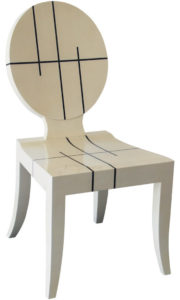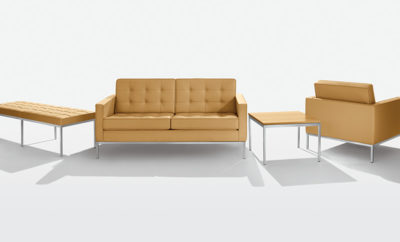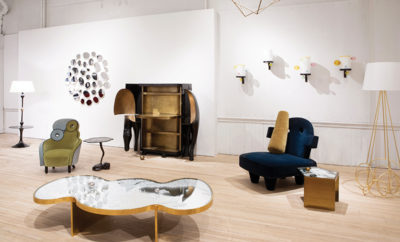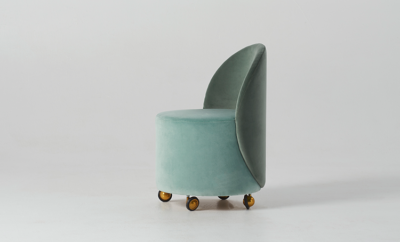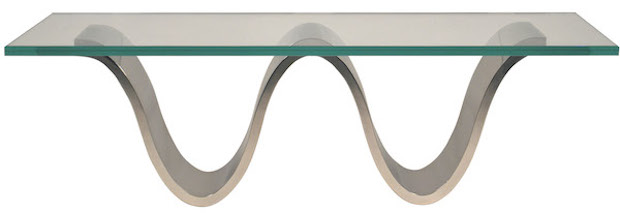 JUNE TRIOLO
JUNE TRIOLO
Feature
A Pioneer and a Force: Sally Sirkin Lewis
THE BEST STORIES ARE THOSE IN WHICH the outcome exceeds the expectations set at their somewhat uncertain beginnings. Such is the case with Sally Sirkin Lewis, the force of nature behind the L.A.–based furniture and home goods company J. Robert Scott. Credited with pioneering the “California” style of the 1970s and recognized as an influential proponent of the “modern classic” and “transitional” styles, Lewis has built an empire on her furniture and textile designs. Her aesthetic transcends all these designations, however, with its distinct cast of luxury and a standard of quality usually reserved for fine art and haute couture. Her interiors, furniture, and finishes are inspired by everything from modern art, historical architecture, and high-end fashion to the textures of neighborhood trees, the gradients of watercolors, and the subdued colors of dried spices. “I just did what came to me. Everything comes from somewhere; inspiration lives everywhere. I never questioned anything; I just wanted to express myself.”
A member of the design world for more than forty years, Lewis is not always known by name outside the industry in which she has thrived so prodigiously. “I always say I’m the best-kept secret,” she says. This inconspicuousness is due in part to the fact that her company’s handle is an amalgam of her children’s names, rather than her own—a strategic choice, and a sign of the times when she opened her first store on Melrose Avenue in West Holly- wood in 1972. What is the secret to her enduring success? Perhaps it’s the simple mantra she repeats throughout our interview, “What is good, is always good.”
Lewis knows how to distill the best bare essentials from functional forms without sacrificing their warmth or comfort. Many of her best pieces are derived from classical furniture designs and historical antecedents pared down to their most modern and functional bones. An eighteenth-century fauteuil revised by Lewis feels unexpectedly contemporary and timeless. An exception to the trend-driven tendencies of the current market, Lewis creates investment pieces that are meant to last: “I don’t tire of people I love. The same goes for furniture and art— if I love it, I love it forever.” She goes on to say, “Disposable impermanence is toughest for me to accept in this industry. I [can’t] subscribe to that.”
So how did an art student from Miami with vague ambitions of becoming a fashion designer emerge as one of the world’s most successful interior, furniture, and textile designers? By an essential, if somewhat undervalued, device: chance. Lewis will be the first to tell you, however, that while spectacular accidents can get you in the door, longevity is hard won with work and talent. “Back then in Miami, I wanted to be in fashion. One day I took my little girl to the beach and was sketching. A woman came up to me, quite randomly, and said: ‘I’ve been watching you; you have such a sense of style. Would you do my house?’ I protested and said, ‘I don’t know the first thing about it,’ but she insisted. ‘I’ll show you where to go.’ I took to it like a sh to water.” This first project led to a phone call some months later looking for “Sally Sirkin, the interior design- er,” and the rest is history.
Lewis’s early foray into interiors sparked the discovery of a remarkable intuition. “I have such a love of space. I draw everything intuitively without measurements. I can visualize everything; I see it all in my head and how each component relates to the other.” A tireless perfectionist, Lewis’s attention to detail eventually demanded she de- sign and manufacture the furnishings for her interiors. “I just can’t compromise,” she says. At the risk of belaboring a point, Lewis quite famously moved homes to accommodate the acquisition of a nine-foot painting by American abstract expressionist Adolph Gottlieb, an anecdote that attests to her unwavering nature, not to mention her love of art.
Lewis now has J. Robert Scott showrooms in Los Angeles, New York, Chicago, Dallas, London, and Hong Kong, and has designed every detail in each one. When she first opened in 1972, her showroom was unlike any- thing that had come before. Spacious and open, with trees rather than dividing walls, white upholstery, and sisal flooring and straw wall coverings—both used as inexpensive solutions to a rundown space on a modest budget—it ushered in a new era of design. At the time, as Lewis points out, “no one thought we’d last six months.” Despite the uncertain beginnings, Lewis has since been inducted into the Interior Design Hall of Fame, recognized by the L.A. Times as one of its fifty Titans of Design, and has been listed among Architectural Digest’s AD100. She has more than 150 design patents worldwide, including one for a proprietary ombré finishing technique that can replicate the subtlety of watercolors on veneer.
All the furniture designed by Lewis is made in a 76,000-square-foot factory in Inglewood, California. She employs more than a hundred craftspeople, some of whom have worked for her for more than twenty years. The domestic production of all her designs not only affords her a hand in every step of the process but also allows her to create bespoke products for clients all over the world. Everything she has created can be customized and altered minutely, like a fine art commission or an haute couture garment, and Lewis herself is single-handedly responsible for designing ninety-nine percent of everything that is manufactured by the company. No one else, anywhere, works like this.
Some forty years on, she shows no signs of retiring or scaling back. Infectiously charismatic, Lewis states matter of factly at the end of our interview, “I was never afraid to do anything.” Her fearlessness shows in every manifest outcome. She has an iron will with a soft touch. jrobertscott.com


